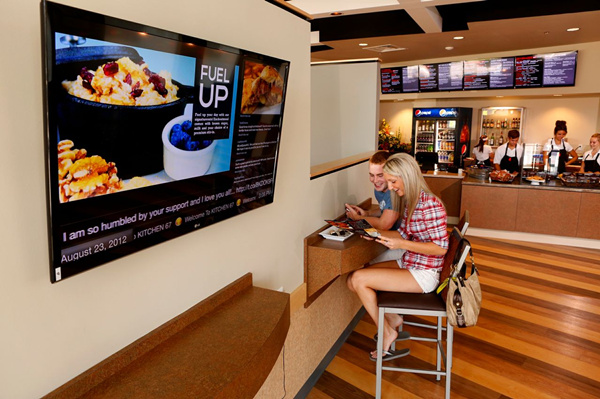
Digital signage has evolved significantly. In its earliest days, updates were manual and costly. Systems offered low compliance and low reliability. Screens were not networked and the reach and impact of their content was not measurable.
近些年来,数字标牌显著发展。在其发展早期,更新都是依靠人力的,并且成本非常高。系统的依从性和可靠性都非常低。屏幕也都不是联网的,所以其内容的覆盖率和影响都是不可测的。
With the automation of digital signage and the development of medium-specific software, compliance and reliability were improved. Screens were networked and audience measurement became possible. Costs remained high.
随着数字标牌的自动化和特定软件的不断发展,数字标牌的依从性和可靠性都有明显提高。屏幕也都是联网的,使得受众调查也成为可能。然而成本还是一如既往的高。
Today, reliability is higher still. Cloud-based services have improved measurability and helped reduce overall costs. In turn, the adoption of digital signage has grown and accelerated further.
现如今,数字标牌的可靠性仍然很高。云服务系统提高了其受众可测量性,并且还能降低总成本。反过来,数字标牌应用已经得到了进一步加速发展。
Static signage still matters too, of course. While digital signage has answered many challenges, it is not suitable for all of them. There are and always will be many different formats for signage, including printed posters that can be installed at the individual store level by employees, in contrast to centrally managed digital signage content.
当然,静态标识仍然很重要。虽然数字标牌克服了许多困难,但是它并不适用于所有的领域。标识总是分为很多不同形式的,包括可以安装在个人商店里的喷印海报,它与集中管理的数字标牌形成了鲜明的对比。
That said, there is still more for digital signage to do. Content, for example, can become more timely and relevant through proximity marketing, more finely targeted ads, triggered content and well-curated data feeds. Media players, meanwhile, will continue to become smaller, faster and less expensive.
也就是说,数字标牌仍然有很大的发展空间。例如,数字标牌显示的内容可以通过临近行销变得更加实时化和明确化,做出更有针对性的广告、触发性内容和组织化的数据服务。同时,媒体播放器会继续变得更小、更快、更便宜。

Software, too, will become commoditized. As the scale of digital signage networks continues to increase, the costs of providing software-as-a-service (SaaS) are falling. In short, the capabilities of the technology are soaring while the costs of implementation and operation continue to drop.
软件也变得更加商品化。由于数字标牌网络规模不断扩大,软件即服务的成本不断下降。总而言之,技术功能不断提高的同时,安装操作成本却不断下降。
Both small and large digital signage customers are looking to outsource several key functions relating to their networks, including (a) the creation and management of content and (b) the management and monitoring of their networks. Each of these functions represents an opportunity for sign shops.
小型和大型数字标牌客户都在想把与网络相关的几个关键功能外包出去,包括(a)显示内容的创新和管理,(b)网络的管理和监控。这些功能都代表了标识商铺所拥有的机会。
Service-oriented signage
定向服务标识
Retail stores and restaurants are especially opportunity-rich environments. Chains want to see incremental sales improvements, while independent businesses seek to break through to new customers. Adoption rates of digital signage in these markets are soaring, creating an air of inevitability and necessity, particularly as customers come to expect to see screens in use.
零售商店和餐馆都是特别需要数字标牌的场所。连锁企业期望看到增量式销售额的不断提高,而独立企业则想要打破传统吸引新客户。数字标牌在这些领域的覆盖率不断增大,体现出一种必然性和必要性,尤其是当客户期望看到屏幕得到使用之后。

Lower price points and proven case studies are also making it easier for these businesses to adopt digital signage. There are now many successful examples of promotional retail screens, menu boards, ambient content, video walls, interactive displays, drive-thru boards, wayfinding, assisted selling, tabletop and countertop displays, corporate communications and training.
更低的价格和经过验证的案例研究都使得数字标牌更加适用于这些领域。现在已经有许多成功的促销零售板、菜单板、外界环境信息、视频墙、交互式显示屏、汽车餐厅板、导视板、辅助营销板、桌面显示板、企业沟通培训显示屏。
Signmakers can uncover many new opportunities in this field by thinking like a customer when visiting retail and food-service establishments and considering what works, what doesn’t and where digital signage content could be of assistance.
标识制作商通过参观零售和餐饮服务设施,能在该领域发现许多新机遇,进而综合考虑有效的和无用的设备,以及有用处的数字标牌内容。
As a signage provider, it is also important to listen to existing clients for various cues, such as “I wish we could …” or “If only we could ….” Acting in a consultative role, signmakers should ask these clients what they are trying to achieve, how they are measuring success and what their own customers and, for that matter, competitors are telling them.
作为一个标识供应商,听懂客户的各种暗示也是很重要的,例如“我希望我们能够...”或“我们要是能...”作为一个顾问性角色,标识制作商应该询问这些客户:他们想要获得的产品效果,他们如何衡量成功以及他们的客户如何衡量成功,对于这个问题,竞争对手都会告诉他们的。
Delivering on objectives
实现目标
A successful digital signage deployment starts with objectives. Both parties—the sign company and the client—need to understand the goals of the project. These in turn will lead to content strategy and technology decisions; never the other way around.
一个成功的数字标牌部署都是从具体目标开始的。标识公司和客户都需要了解整个项目的目标。这些反过来都会通向内容策略和技术决策,但是这永远不会倒过来。

The reason this approach is important is that goals and objectives are measurable elements of the project. Metrics should be established early on and further actions taken upon achievement.
这种方法如此重要的原因是,其目标都是可测量的元素。测量指标要在项目早期完成,然后再采取下一步行动。
For signmakers to take advantage of digital signage opportunities, they need to understand the technical aspects of implementation and field support, but this does not mean they have to offer those capabilities right away. By investing in the right partnerships, they can leverage relationships to become trusted as integrated signage advisors.
对标识制作商来说,要想充分利用数字标牌,他们需要了解安装启用和外场支援的技术形式,但是这并不代表他们必须立刻提供那些技术。通过投资合适的合作伙伴,他们可以利用合作关系成为受信任的综合标识顾问。
In other words, embracing digital signage as a growth opportunity means not only learning about its various elements, but also exploring ways for outside partners’ work to mesh with the needs of the customer base. Joint sales are almost a necessity today, so there needs to be a foundation of trust. Only then can the optimal strategy be developed.
换句话说,坚持将数字标牌看作一个成长机会,不仅意味着要了解各种元素,而且还要探索适合外部合作者需求的方案。现如今联合销售几乎成了一种必然性,因此需要一个信任基础。只有这样才能获得最佳策略。








